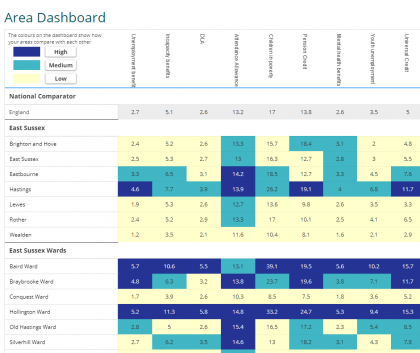
Sussex Community Foundation is one of the 46 community foundations across the UK. It raises funds and makes grants to local projects and groups across the whole of West Sussex, East Sussex and Brighton & Hove ‘inspiring local giving to meet local needs’.
Before using Local Insight, Sussex Community Foundation relied on their local knowledge of their service patch. However, they sometimes found it difficult to be able to back up their claims with evidence in a timely way – especially for some of the very bespoke geographical areas they work with that don’t fit neatly to statistical boundaries.
They wanted a solution that would easily slot into their workflows and with little overhead in order to demonstrate their commitment to data-led decision-making and show that they are best placed to ensure that their grants really make a difference to people’s lives.
We chatted to Hannah Clay, Grant Programmes Manager, at Sussex Community Foundation on their experience of using Local Insight.

The dashboard allows you to compare multiple indicators across multiple areas, all of which is under your control.
We are a place-based funder and we make a strong claim to really understand the local needs of the whole of East Sussex, West Sussex and Brighton & Hove, which is a pretty massive undertaking. We have our own internal knowledge that people have developed over the course of their careers, and there’s a depth of knowledge there that you can’t buy. However, you do need to test that knowledge and Local Insight gives us the ability to back up a lot of our claims, assumptions and knowledge with reliable data.
Equally, being able to drill-down to specific areas of the county wasn’t easy. We relied a lot on our Sussex Uncovered reports, which give a thorough overview of the county as a whole, but it’s not as easy to tell what is going on in specific villages or wards from that, because you are only looking at printed images.
We wanted to do something more to show that we were evidence-based as this is one of our key selling points to prospective donors thinking about asking us to manage their charitable giving. The organisation has grown a great deal in the last few years and we were feeling stretched to back up our claims with the confidence that good data brings.
The access to local data and knowledge was the central driving force. Beyond that, the flexibility and user interface of Local Insight was a huge draw for us. It was very clear, from the first time we saw it, that it was going to be something anybody could use – the most technophobic person could use it quickly and easily, without too much support. As a small organisation, that is really important because we want everybody to be able to use it.
As a team, OCSI are very friendly, approachable and personable. That goes a long way when working with software. The charity sector and what we do is so person-centred, that the fact that this wasn’t just another faceless tech project was really important. The Knowledge Base and quick customer service meant it was really easy to get on board with quickly and made the business case for this particularly easy to sell.
When we are assessing applications, we ask people to provide evidence of need for what they do. We hope they will give us a story and also reference some statistics. Local Insight enables us to verify what they are saying and to add context.
One recent example is an application we received looking at employment training in one specific ward in Eastbourne. I was able to quickly look up data on the Index of Multiple Deprivation (IMD) and Universal Credit in Local Insight, as we already have all of our wards loaded in. In no time at all, I could quickly confirm that this ward did fare particularly badly on unemployment.
Local Insight backs up our knowledge and helps us to support grant assessment, as we can interrogate small and large areas, moving from district to wards very quickly. You can find all the context you need in the maps and reports of Local Insight easily.
We use Local Insight in a couple of ways for funding meetings too. For example, we use the Services functionality to plot application points on the map. We can then show funders their area of benefit visually on the map, alongside point location data on where the applications have come from. We use the Service Types to show which applications were successful and to categorise by theme.
We also use the reports for prospective meetings. Donors become very engaged when you can tell them what is happening on their doorstep. If you can tell them that there are, for example, children living in poverty, or people without access to services, living just a couple of streets away from them, that gives them a deeper understanding of the very immediate need in the locality. Local Insight helps to signify our professionalism, as well as our commitment to modern practice and data-led decision-making to our prospective donors.
We also upload our own data on grants awarded at the end of each round. It’s a useful presentation tool, both internally and externally. As well as explaining the figures, you can take some visual slides along. For example, at our internal grants committee meetings, we can show trustees the amounts of grants applied for and what we have funded in different areas on a map. It is useful to be able to show this side-by-side with the IMD and a great way of showing our impact visually.
Local Insight has also come in useful when working with completely bespoke geographies. For example, our community benefit fund is loosely based around a few wards. The funders were really impressed with the knowledge we could bring to the meeting on what the needs were in that small community. I don’t know how we would have done that before Local Insight – I can imagine we wouldn’t have won some of the contracts we have in the last two years without it.
You don’t know what you don’t know. Local Insight provides access to information and more specific datasets that go beyond just the IMD and things you might find elsewhere. The user experience is such a strong part of the tool and there is no barrier to using it.
If you would like to find out more about how Local Insight can support your team, sign up for a demo and free trial.
This post also appears on the Local Insight website.
Following the release of the second Everybody needs good neighbourhoods report, Stefan…
More
We are proud to have contributed towards the Everybody needs good neighbourhoods…
More
The Community Life Survey (CLS) is an annual survey commissioned by the…
More